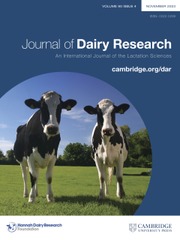Crossref Citations
This article has been cited by the following publications. This list is generated based on data provided by
Crossref.
Åkerstedt, Maria
Waller, Karin Persson
Larsen, Lotte Bach
Forsbäck, Linda
and
Sternesjö, Åse
2008.
Relationship between haptoglobin and serum amyloid A in milk and milk quality.
International Dairy Journal,
Vol. 18,
Issue. 6,
p.
669.
Molenaar, Adrian J.
Harris, D. Paul
Rajan, Gillian H.
Pearson, Monica L.
Callaghan, Megan R.
Sommer, Lilly
Farr, Vicki C.
Oden, Kim E.
Miles, Michelle C.
Petrova, Rosica S.
Good, Laura L.
Singh, Kuljeet
McLaren, Robert D.
Prosser, Colin G.
Kim, Kwang S.
Wieliczko, Robert J.
Dines, Mark H.
Johannessen, Kirsti M.
Grigor, Murray R.
Davis, Steven R.
and
Stelwagen, Kerst
2009.
The acute-phase protein serum amyloid A3 is expressed in the bovine mammary gland and plays a role in host defence.
Biomarkers,
Vol. 14,
Issue. 1,
p.
26.
Åkerstedt, Maria
Waller, Karin Persson
and
Sternesjö, Åse
2009.
Haptoglobin and serum amyloid A in bulk tank milk in relation to raw milk quality.
Journal of Dairy Research,
Vol. 76,
Issue. 4,
p.
483.
Safi, Shahabeddin
Khoshvaghti, Ameneh
Jafarzadeh, Seyed Reza
Bolourchi, Mahmoud
and
Nowrouzian, Iradj
2009.
Acute phase proteins in the diagnosis of bovine subclinical mastitis.
Veterinary Clinical Pathology,
Vol. 38,
Issue. 4,
p.
471.
Gerardi, Gabriele
Bernardini, Daniele
Azzurra Elia, Carla
Ferrari, Vanni
Iob, Luciano
and
Segato, Severino
2009.
Use of serum amyloid A and milk amyloid A in the diagnosis of subclinical mastitis in dairy cows.
Journal of Dairy Research,
Vol. 76,
Issue. 4,
p.
411.
Chan, Jacky Peng‐Wen
Chang, Chao‐Chin
Hsu, Wei‐Li
Liu, Wen‐Bor
and
Chen, Ter‐Hsin
2010.
Association of increased serum acute‐phase protein concentrations with reproductive performance in dairy cows with postpartum metritis.
Veterinary Clinical Pathology,
Vol. 39,
Issue. 1,
p.
72.
Eckersall, P.D.
and
Bell, R.
2010.
Acute phase proteins: Biomarkers of infection and inflammation in veterinary medicine.
The Veterinary Journal,
Vol. 185,
Issue. 1,
p.
23.
Åkerstedt, Maria
Forsbäck, Linda
Larsen, Torben
and
Svennersten-Sjaunja, Kerstin
2011.
Natural variation in biomarkers indicating mastitis in healthy cows.
Journal of Dairy Research,
Vol. 78,
Issue. 1,
p.
88.
Ceciliani, F.
Ceron, J.J.
Eckersall, P.D.
and
Sauerwein, H.
2012.
Acute phase proteins in ruminants.
Journal of Proteomics,
Vol. 75,
Issue. 14,
p.
4207.
Szczubiał, M.
Dąbrowski, R.
Kankofer, M.
Bochniarz, M.
and
Komar, M.
2012.
Concentration of serum amyloid A and ceruloplasmin activity in milk from cows with subclinical mastitis caused by different pathogens.
Polish Journal of Veterinary Sciences,
Vol. 15,
Issue. 2,
p.
291.
Keane, O. M.
Budd, K. E.
Flynn, J.
and
McCoy, F.
2013.
Increased detection of mastitis pathogens by real‐time PCR compared to bacterial culture.
Veterinary Record,
Vol. 173,
Issue. 11,
p.
268.
Thomas, Funmilola Clara
Waterston, Mary
Hastie, Peter
Parkin, Timothy
Haining, Hayley
and
Eckersall, Peter David
2015.
The major acute phase proteins of bovine milk in a commercial dairy herd.
BMC Veterinary Research,
Vol. 11,
Issue. 1,
Fathi, Ezzatollah
Hamali, Hosein
Kaleibar, Mohamad Tolouei
and
Farahzadi, Raheleh
2015.
Application of acute phase proteins as indicators of retained placenta and their relation to energy metabolites in postcalving dairy cows.
Comparative Clinical Pathology,
Vol. 24,
Issue. 1,
p.
47.
Lemos, Vânia F.
Guaraná, Eduardo L.S.
Afonso, José A.B.
Fagliari, José J.
Silva, Paulo C.
Soares, Pierre C.
and
Mendonça, Carla Lopes de
2015.
Effects of intramammary infection on whey proteinograms of sheep during lactation.
Pesquisa Veterinária Brasileira,
Vol. 35,
Issue. 3,
p.
230.
Pongthaisong, Pongphol
Katawatin, Suporn
Thamrongyoswittayakul, Chaiyapas
and
Roytrakul, Sittiruk
2016.
Milk protein profiles in response to Streptococcus agalactiae subclinical mastitis in dairy cows.
Animal Science Journal,
Vol. 87,
Issue. 1,
p.
92.
Verma, Aparna
and
Ambatipudi, Kiran
2016.
Challenges and opportunities of bovine milk analysis by mass spectrometry.
Clinical Proteomics,
Vol. 13,
Issue. 1,
Jaeger, S.
Virchow, F.
Torgerson, P.R.
Bischoff, M.
Biner, B.
Hartnack, S.
and
Rüegg, S.R.
2017.
Test characteristics of milk amyloid A ELISA, somatic cell count, and bacteriological culture for detection of intramammary pathogens that cause subclinical mastitis.
Journal of Dairy Science,
Vol. 100,
Issue. 9,
p.
7419.
Magro, Massimiliano
Zaccarin, Mattia
Miotto, Giovanni
Da Dalt, Laura
Baratella, Davide
Fariselli, Piero
Gabai, Gianfranco
and
Vianello, Fabio
2018.
Analysis of hard protein corona composition on selective iron oxide nanoparticles by MALDI-TOF mass spectrometry: identification and amplification of a hidden mastitis biomarker in milk proteome.
Analytical and Bioanalytical Chemistry,
Vol. 410,
Issue. 12,
p.
2949.
Simões, P.B.A.
Campbell, M.
Viora, L.
Gibbons, J.
Geraghty, T.E.
Eckersall, P.D.
and
Zadoks, R.N.
2018.
Pilot study into milk haptoglobin as an indicator of udder health in heifers after calving.
Research in Veterinary Science,
Vol. 116,
Issue. ,
p.
83.
Hussein, Hany Ahmed
Abd El-Razik, Khaled Abd El-Hamid
Gomaa, Alaa Mohamed
Elbayoumy, Mohamed Karam
Abdelrahman, Khaled A.
and
Hosein, H. I.
2018.
Milk amyloid A as a biomarker for diagnosis of subclinical mastitis in cattle.
Veterinary World,
Vol. 11,
Issue. 1,
p.
34.




